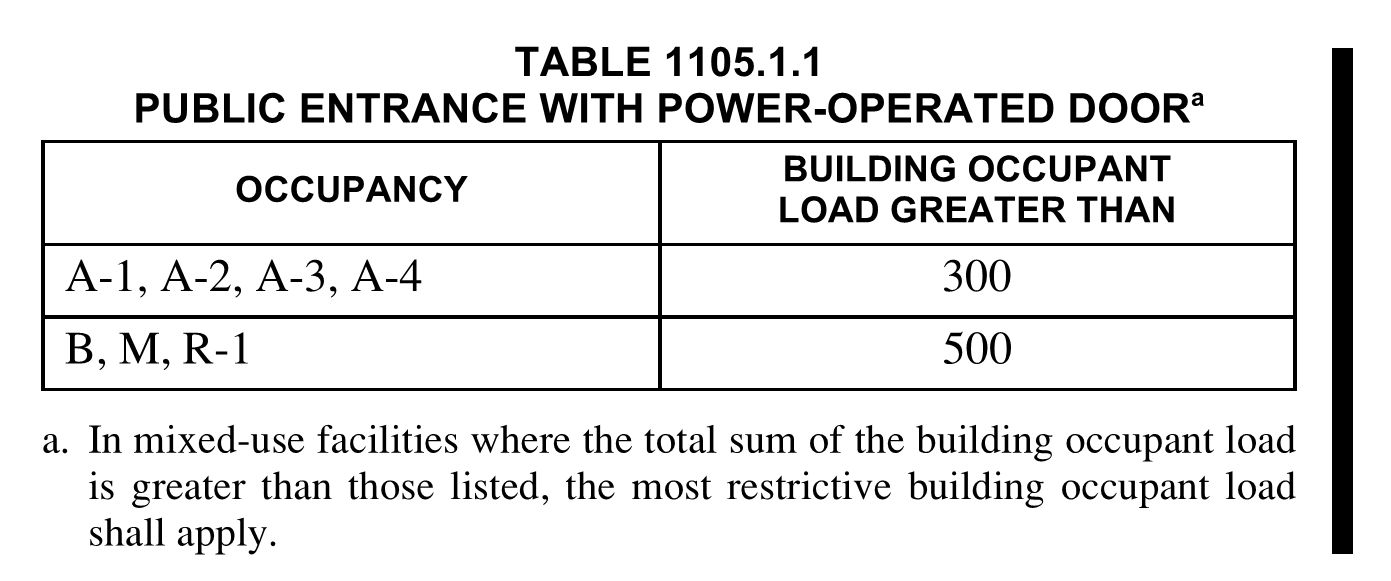 Whenever I go back to look for a post, I’m always surprised by how much time has passed since it was written. More than 2 years ago I wrote about a change that was in progress for the International Building Code (IBC), and almost 3 years ago I published a post about changes to ICC A117.1 – Accessible and Usable Buildings and Facilities; both articles address new requirements for automatic operators at public entrances.
Whenever I go back to look for a post, I’m always surprised by how much time has passed since it was written. More than 2 years ago I wrote about a change that was in progress for the International Building Code (IBC), and almost 3 years ago I published a post about changes to ICC A117.1 – Accessible and Usable Buildings and Facilities; both articles address new requirements for automatic operators at public entrances.
In the 2021 edition of the IBC, public entrances are defined as “An entrance that is not a service entrance or a restricted entrance.” The requirements for these entrances are included in Section 1105 – Accessible Entrances. This section states which entrances must be accessible, and that in addition to the types of entrances specifically referenced in the section, at least 60 percent of all public entrances must be accessible.
A new paragraph and table have been added with regard to public entrances:
1105.1.1 Automatic doors. In facilities with the occupancies and building occupant loads indicated in Table 1105.1.1, public entrances that are required to be accessible shall have one door be either a full power-operated door or a low-energy power-operated door. Where the public entrance includes a vestibule, at least one door into and one door out of the vestibule shall meet the requirements of this section.
(Note that the solid black vertical line indicates a change from the previous edition of the code.)
The intent of this change is for buildings in certain use groups (more on those here) to have automatic operators on at least one door or one set of doors (exterior and vestibule) at each public entrance that is required to be accessible. The operators can be either full power operated or low energy power operated. A power-assist operator would not meet the requirements because it only reduces the opening force, it does not open the door automatically. The requirement applies to all assembly occupancies except A-5, along with business, mercantile, and R-1 residential occupancies.
This change affects jurisdictions where the 2021 edition of the IBC is adopted. If you have any questions, leave them in the comment box and I’ll write a follow-up post.
You can purchase the 2021 IBC by visiting iccsafe.org.
You need to login or register to bookmark/favorite this content.






Maybe I’m hard-headed, but I’m having trouble with “public entrances”. The added operator wording doesn’t clarify.
Let’s make a scenario for discussion:
An arena (A-4) has one main public entrance. Because of the number of people (>300) this arena holds, this main entry has five double doors. All other doors are either emergency egress or service entrances. If 60% of entrances have to be accessible, is this one door (making this whole “public entrance” accessible), three doors (60% of 5), or all five? Do we need one automatic operator, three, or five?
If the same arena has three public entrances (still five double doors; 2, 2, & 1), will we have two accessible entrances (60% of 3)? Is that four accesible doors or two? How many operators?
The wording is not crystal clear.
Does a power operator like the LCN 4642 with push buttons meet the intent of the code? The door is not “fully” automatic opening since it requires the person to push a button instead of a motion activated opening of the door.
What about buildings that require card access to enter with large assembly rooms? Does this fall under the exception to a restricted entrance? They are not truly public but might have a large number of visitors. An example might be a courthouse or other government building. Would you suggest an operator that is controlled by a card reader or keypad? In the past I have installed an operator on the inactive door with no external hardware, this way the active door is used by able bodied and set a longer open time on the door with the operator.
Hi Greg –
Yes – low-energy operators meet the requirements of the 2021 IBC, and low-energy operators are operated by a knowing act – like an actuator switch. If a door has access control it can still have an automatic operator…whether the entrance is considered public may depend on the AHJ’s interpretation of the code.
– Lori
Accessible doesn’t mean automatic entrances. it states 60% must be Accessible and of those 60% 1 would need to be provided with a automatic opener. This is how i would interpret the verbiage.
I agree – that’s how I would interpret the change as well. Was there something in my post that made it sound otherwise?
– Lori
I thought I understood this until I saw the comment from Dan Thompson and the reply from Lori Greene.
Is it one door of the 60% that are accessible entrances or one door at each of those locations that has accessible entrances? If there are 12 accessible entrances around the building, does one door at each of the 12 locations require an operator? At the end of Lori’s post today (4/6), she states one operator at EACH public entrance (or set of doors).
The statement by Dan Thompson seems to indicate that if there are ten public entrances, six of them (60%) must be accessible but only one needs an operator. Lori’s response seems to confirm that.
The two scenarios seem to contradict each other.
Hi Eric –
The way I understand it, it is 1 door or set of doors at each of the public entrances that is required to be accessible. At least 60% of public entrances are required to be accessible (plus some other types of entrances that are specifically listed in the IBC). At the 60% of entrances designated as accessible, 1 door or 1 set of doors (exterior and vestibule) needs automatic operators. Does that make sense?
– Lori
How would this affect multifamily entrances or amenity rooms that are assembly spaces?
I see no mention of E occupancy but I’m assuming if a school has an assembly occupancy (cafeteria, gym, etc.) and the overall occupant load is greater than 300, then this section would apply. Can anyone advise?